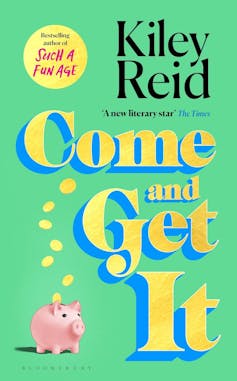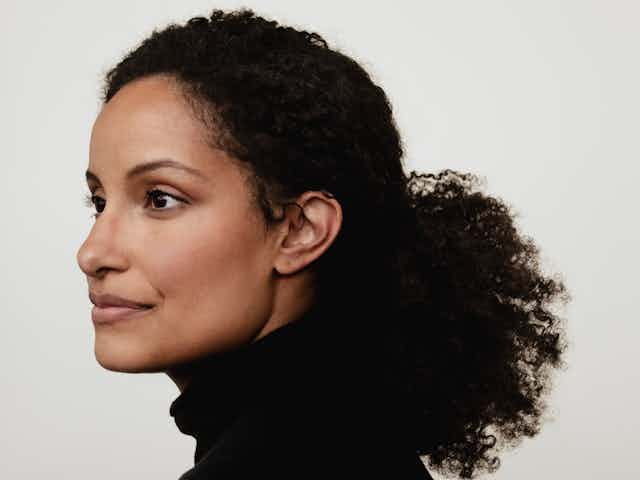At the beginning of Come and Get It, the second novel from the Booker longlisted author of Such a Fun Age, college student Tyler presses $20 on Millie, her resident assistant. Millie, whose job it is to look after the students in the dorm, has helped Tyler sort out an awkward interpersonal situation.
Tyler’s roommate, Kennedy, has filled her side of their dorm room with an immense amount of stuff. Tyler doesn’t know how to talk to her about it, so Millie deftly assists with a roommate switch.
Millie doesn’t exactly accept the money. Indeed, she tries to refuse it several times. But it ends up in her possession anyway. This becomes, in many ways, the beginning of an internal schism – between who she thinks she is and how she is read by the people around her. When taking this $20 bill comes back to haunt her, this schism will become eminently clear.
Review: Come and Get It – Kiley Reid (Bloomsbury)
On the surface, Come and Get It is a book about money. It has three perspective characters, each with a different, multilayered relationship to money.
Millie, the resident assistant who accepted the fateful $20, is one of the few Black students in her dorm at the University of Arkansas. She’s working as hard as possible (and at as many jobs as possible) to achieve her goal of home ownership, “after becoming mildly addicted to TV shows featuring tiny houses and youngish owners”.
Kennedy is one of Millie’s residents, a perpetually lonely undergraduate who uses trips to Target – a place which feels like “home” to her – as a way of coping with the lack of connection with her peers (hence the overstuffed dorm room).
Agatha is a visiting professor to the university who becomes fascinated with students’ relationships to money while conducting a research focus group about weddings with students in Millie’s dorm. She starts paying Millie – meaningfully, in $20 bills – to listen in to the dorm residents’ talk every Thursday night, which becomes the basis of several pieces she publishes (without telling Millie or any of the students she’s eavesdropping on) in Teen Vogue.

Questions of identity
The Teen Vogue pieces are a neat illustration of some of the broader questions the book grapples with – questions about money, yes, but also questions about identity.
Agatha renders these pieces as if they were interviews; however, they are in fact caricatures, cobbled together from out-of-context, cherry-picked quotes from both the initial focus group Agatha conducted and from things she overheard while eavesdropping from Millie’s room.
Agatha is aware what she’s doing is wrong:
It did feel unfair to paint the young women with a two-dimensional sheen [… She] knew firsthand that Tyler, Casey, and Jenna were not composed solely of pull quotes.
She even vaguely intends to correct it: “the book book, that was where she would right her current wrongs. That was where she’d interview college women the right way, under the umbrella of a signed release.”
But as the interviews become more and more popular, the lure of their success – and the accompanying social media followers and royalties bump for her older books – proves too great, and she starts to push the ethical boundaries even further.
Yet despite her actions, Agatha’s image of herself does not change. Even when she starts sleeping with Millie – an undergraduate student 14 years younger than her – she continues to justify it to herself, so as to maintain her self-image as an ethical scholar.
Yes, she’s sleeping with a student, but not her student. Yes, Millie is younger than her, but she’s not that young. Yes, there’s a power differential, but honestly, it’s not as bad as you think (which, as another reviewer has aptly noted, is a common preoccupation of professors sleeping with students in campus novels, though those professors are usually men).
Judging the characters
“Show, don’t tell” is an incredibly common piece of storytelling advice (a blunt instrument, yes, but certainly one I’ve used in my creative writing classroom and will probably use again). Come and Get It digs into the gap between the two concepts. The novel is fascinated by versions of the self – the narrative of the self we tell to ourselves, versus the version of ourselves others read from what we show them through our actions.

It would be tempting to read this slippage as an invitation to pass judgement on the characters. Indeed, at many points, it is impossible not to – we are, after all, readers, and these characters are there to be read.
For example, I, a female academic of approximately Agatha’s age who uses many similar research methods, had some extremely strong opinions about her ethics (and lack thereof). When she is confronted about her unethical behaviour towards the end of the book, I found it immensely satisfying.
Likewise, it is very difficult not to feel sympathy for Millie – to believe in the version of herself she has in her mind, rather than the image a dispassionate list of her actions would create. This is particularly true when the whiteness of the people around her is cast in sharp relief: there are facets to her identity that her white friends, however well-meaning, simply cannot parse.
And there is perhaps no greater invitation for the reader to pass judgement than with Kennedy. For the first half of the book, she is easily the least interesting of the three perspective characters – a lonely college student worried about making friends, unsure how to reach out to the three students Agatha is busy turning into caricatures in Teen Vogue.
At about the midpoint, though, the horrifying reason Kennedy transferred from her old university is made clear. Despite Kennedy’s mother emphatically telling her that she is “not a bad person”, we as readers are inevitably provoked to form our own opinion.
People are complicated
But the point here is not deciding whether characters are good or bad, moral or immoral, their actions justified or unjustified. The point is – perversely – a simple one: it’s complicated.
One of the things Agatha notes about Millie is that she is gifted at impressions. For instance, when Agatha asks her what the students she’s eavesdropping on mean when they talk about “believers”, Millie does the following impression of “a cool, nature-y Christian person who is … probably white”:
So, Agatha. Listen. Can I talk to you for a second? God’s really putting Hannah on my heart this week … The other day? […] And keep this between you and me – but the other day she did blah blah blah? And yeah, it just wasn’t the sweet Hannah that we know. And I need to figure out a way to hold her accountable while I do my best to shower her with grace. But I also want to start asking important questions, like, is this a godly friendship? Is she going through a rough season? And maybe she is! And that’s okay. But if that’s the case, is my birthday weekend at Hilton Head the best place for her to do that?
Millie’s ability to do comedic impersonations is one of the things Agatha finds most appealing about her – perhaps unsurprising, given she’s essentially in the business of comedic impersonations herself, with her Teen Vogue pieces.
But it’s also symptomatic of the broader theme running through the book: the tension between who people are (complex, three-dimensional) and who we interpret them to be (frequently stereotypes or caricatures, because we lack key pieces of context).
This is a book liberally peppered with similes and comparisons. “She looked like the kind of person who slept eight hours every night”, “she looked like any of the redheaded celebrities when their names were put into search engines with grocery store or no makeup”, “he had the complexion of a person who loves ‘being out on the lake’”. These approximations are a sentence-level demonstration of the impossibility of capturing the complexity of a whole human being.
Tellingly, the first time Agatha meets Millie, she interprets her as a caricature of her job: “she looked like an adult poking fun at campus life, someone dressing like an RA for Halloween”.
Life under capitalism
There is no denying Come and Get It is a book about money. The crisply folded $20 bill is hardly the only financial motif. However, in many ways, the characters’ relationships to money are some of their most legible attributes.
Millie is painstakingly saving it, in order to buy a house. Kennedy spends it in order to make herself feel better. Agatha is financially secure, but not so secure she cannot be capable of irritation at her ex-partner’s financial cavalierness, and profoundly tempted by the money Teen Vogue offers her.
This is interesting, but perhaps not particularly revelatory, especially when it comes to the murky ethical territory money leads the characters into. Life under capitalism is complicated. We know this.
The ways this book considers the gulf between the version of ourselves in our own minds and the one read by other people, though, are fascinating – making it a worthy follow-up to Such a Fun Age.
People are fundamentally, and perhaps ungraspably, complicated – something Reid does a substantially better job of capturing in this book than Agatha does in her Teen Vogue pieces.

